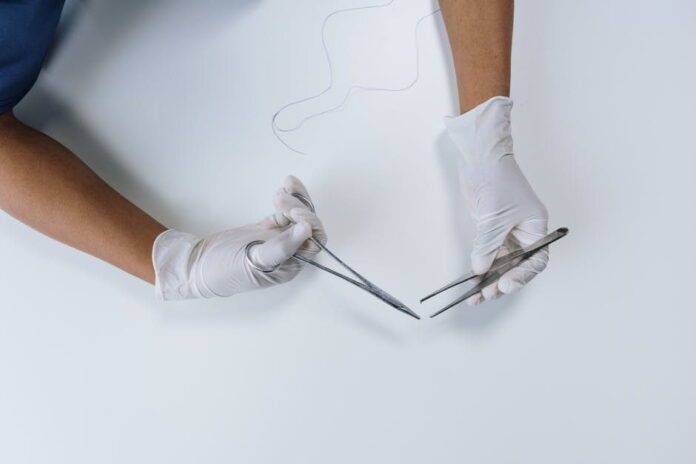Between 40-50 million surgeries take place each year in the United States. Suturing is a vital skill for all types of surgeons. It can be a life-saving technique in emergency situations.
Mastering suturing techniques is essential for providing the best patient care. It requires a high level of dexterity, precision, and hand-eye coordination. It can only be attained through consistent practice.
This is where suture practice, comes into play. In this article, we will explore different methods to practice suturing and improve your suture skills.
These will help whether you are a beginner or a seasoned professional. Our tips and techniques will help you improve your suturing skills.
Benefits of Practicing Suturing
Suturing is a crucial skill for medical professionals. Practicing suturing can provide a range of benefits. One of the key advantages is the improvement in hand-eye coordination.
By performing sutures often, you can develop greater precision in your movements and increase your dexterity. This can translate to improved performance in other areas of medicine and surgery.
Suture practice can also improve your spatial awareness. This is because suturing requires you to work within a specific area. You must be able to navigate and manipulate instruments with precision and care.
Knot tying is an essential part of suturing. By practicing this skill, you can develop a greater understanding of how to tie different types of surgical knots.
This is useful in emergency situations, where time is of the essence. The ability to tie a secure knot fast can make all the difference.
Suture for Beginners
If you’re new to suturing, it can be intimidating to try the technique for the first time. With a bit of practice and the right tools, you can develop your suture skills. Here are some tips to help you get started:
Familiarize Yourself With the Tools
To practice suturing, you’ll need to buy a suture practice kit. They include suturing needles, thread, and forceps. Make sure you know what each tool is used for before you start.
Start with Easy Materials
It’s best to start practicing suturing on soft, pliable materials such as fruit or foam. This will prepare you to move on to tougher materials like skin.
Practice Your Hand-eye Coordination
Suturing requires a lot of precision and dexterity. Practice moving the needle through the material while keeping your hands steady.
Watch Instructional Videos
There are plenty of instructional videos available online. They can help you learn the basics of suturing. Watch these videos to get a better understanding of the technique.
Don’t be Discouraged
Suturing is a skill that takes time to develop. Don’t be discouraged if your first attempts are not perfect. With practice and patience, you can master the technique of suturing.
Suturing on Fruit
For beginners, practicing suturing on fruit is an excellent way to get started. Not only is it cost-effective, but it mimics the texture and toughness of human skin.
When practicing suturing on fruit, it is important to choose the right fruit. Apples, pears, and oranges are some of the best fruits for suturing practice.
To prepare the fruit for suturing, wash it and cut it in half. Make sure to remove any seeds or pits from the fruit. Using a suturing needle and thread, practice suturing the two halves of the fruit together.
Common Mistakes to Avoid
Suture for beginners can be tricky. One of the most common mistakes they make while practicing on fruit is pulling the thread too tight. This leads to fruit splitting.
It is crucial to make even stitches and place them at the right distance from each other.
Suture Practice Kits
Suture practice kits are an excellent tool for beginners who want to master the art of suturing. These kits come equipped with all the necessary items required for practicing suturing. They make it easy and convenient for beginners to start.
There are different types of suture practice kits available in the market. The most common type is the basic suture practice kit. It includes suturing needles, suturing thread, and forceps.
Other advanced kits may include more items such as:
- Suture pads
- Scissors
- Practice skin
The basic suture practice kit is an excellent choice for beginners who want to learn how to suture without spending too much money. The kit is portable, making it easy to practice suturing on the go. These kits are inexpensive, making it an affordable option for:
- Medical students
- Interns
- Residents
Beginners should start by familiarizing themselves with the different types of suturing needles and threads. Once they understand the various types, they can begin practicing suturing techniques using the kit’s tools.
Tips to Improve Suture Skills
Suturing is a skill that requires consistent practice and attention to detail to master. Here are some tips to improve your suturing skills. This will increase your confidence in performing this essential technique.
Practice Different Suturing Techniques
One of the best ways to improve your suturing skills is to practice different suturing techniques often. This will help you become familiar with the different types of sutures and the best situations to use them. Focusing on proper needle handling helps to avoid damaging tissues and achieve precise stitches.
Knot Tying
Another key aspect of suturing is knot tying. Mastering the proper technique for knot tying improves the strength and appearance of the suture.
One helpful tip for knot-tying is to use a consistent knot-tying technique for all sutures. Ensure that they are uniform in size and appearance.
Stress-Free Environment
Practicing suturing in a stress-free environment can also be beneficial for improving skills and building confidence. It is important to create a comfortable and relaxed environment that mimics a clinical setting. This can help reduce anxiety and improve performance.
Get Feedback
Seeking feedback from mentors or experienced professionals is helpful in improving suturing skills. They can provide valuable insights into proper techniques and offer tips for improvement.
Upgrade Your Skills With a Suture Practice Kit
Consistent suture practice is necessary for all medical professionals. It’s even more crucial for beginners to develop their skills. There are various methods and kits available for practicing at home.
This guide provides many tips to improve suturing skills. By following these tips and using the right tools, beginners can develop their suture skills and gain confidence. Stay up to date on the medical industry by reading more articles in our practice management category.
Read Also
- Ketamine-Assisted Therapies: Impacts on Employee WellbeingWorkplace stress is common today. Many employees feel tired, anxious, or burned out. Regular therapy can help, but some people need more support. Ketamine-assisted therapy is showing good results for mental health. A ketamine-assisted therapist guides each session safely. This therapy can improve mood, focus, and energy. Learning more about it can help teams stay… Read more: Ketamine-Assisted Therapies: Impacts on Employee Wellbeing
- The Future of Men’s Health: Why Telehealth Is Here to StayTelehealth isn’t just a pandemic trend that faded into the background. For Australian men, it has become one of the most practical, time-saving, and stress-free ways to manage everyday health — and it’s shaping the future of how we access care. Platforms like DOCTO, an Australian online doctor and specialist telehealth service, are leading the… Read more: The Future of Men’s Health: Why Telehealth Is Here to Stay
- How to Build a Simple, Clean Skincare Routine ?You don’t need a complicated skincare routine. It doesn’t have to be something that requires twenty different products and confusing steps. Your routine works well with just a few high-quality clean ingredients. The beauty industry keeps pushing more products, but your skin actually needs less. You only need a simple approach to get better results… Read more: How to Build a Simple, Clean Skincare Routine ?
- How Preventive Dental Care Supports Overall HealthHave you ever wondered how a simple dental checkup could impact your entire body? Oral health is more than just a bright smile. Studies show that poor dental habits can contribute to serious health problems. Gum disease and tooth decay are linked to heart disease, diabetes, and infections. Yet, many people overlook preventive dental care.… Read more: How Preventive Dental Care Supports Overall Health
- Seeing Clearly in a High-Tech World: A Deep Dive into Advanced Vision Care ServicesProtecting your eyesight isn’t optional—it’s essential. Modern eye care has evolved far beyond basic exams, offering advanced diagnostics, personalized treatments, and surgical innovations that keep vision sharp for life. A leading example is Intermountain Eye Center, home to specialists like Dr Fishburn Boise, where patients receive comprehensive, high-level vision care designed to preserve long-term eye… Read more: Seeing Clearly in a High-Tech World: A Deep Dive into Advanced Vision Care Services
- Why the Keto Diet Works for Some People—and Fails Dramatically for Others: An Ayurvedic Breakdown for Modern HealthcareThe keto diet has dominated weight-loss culture for years. For some people, it produces rapid fat loss, stable energy, and improved mental clarity. For others—especially those who gain weight easily—it leads to burnout, digestive distress, rebound weight gain, high cholesterol, and a metabolism that feels slower than before. Healthcare often frames this as a discipline… Read more: Why the Keto Diet Works for Some People—and Fails Dramatically for Others: An Ayurvedic Breakdown for Modern Healthcare







